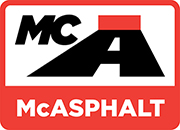Rapid Curing Cutbacks
Asphalt cutbacks use petroleum solvents for fluidifying asphalt cement. The solvents are called distillate, diluents or cutter stock. If the solvent used in making the cutback asphalt is highly volatile, it will evaporate quickly, while solvents of lower volatility evaporate more slowly. Based on the relative speed of the solvent fraction’s evaporation, cutback asphalts are divided into three types: rapid-curing (RC), medium-curing (MC) and slow-curing (SC).
Rapid-curing (RC) cutback asphalt cement is a combination of light diluents with high volatility, typically in the gasoline or naphtha boiling point range, and asphalt cement. Rapid-curing cutback grades include RC-30, RC-70, RC-250, RC-800, and RC-3000.
The degree of fluidity developed in each cutback’s case depends principally on the ratio of solvent to asphalt cement. To a minor degree, the liquidity of the cutback may be affected by the hardness of the base asphalt from which the cutback is made. The degree of fluidity results in several grades of cutback asphalt, some quite fluid at ambient temperatures and others somewhat more viscous. The more viscous grades may require a small amount of heating to make them fluid enough for construction operations.
Rapid curing cutback grades are designed to react quickly and are primarily used in spray applications such as bond/tack coats, aggregate chips seals, sand seals, granular priming and similar surface treatments.
